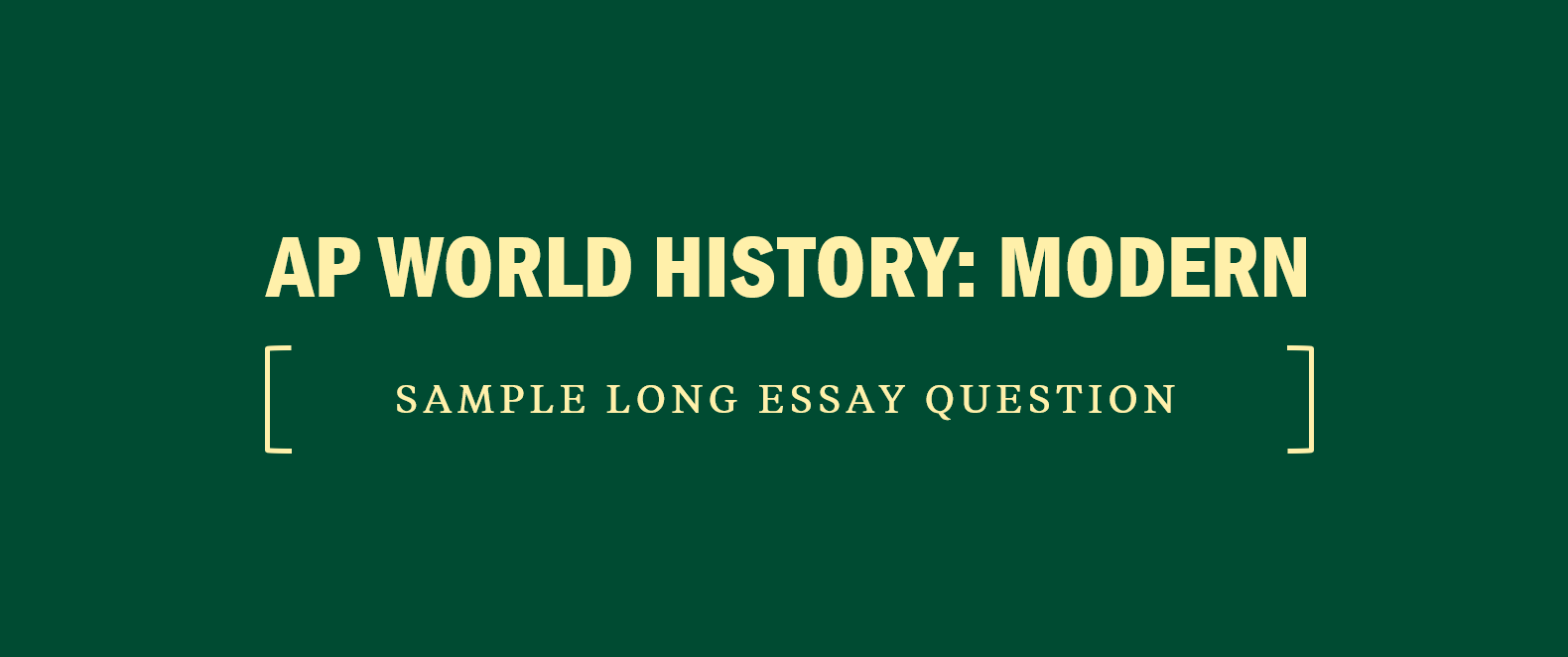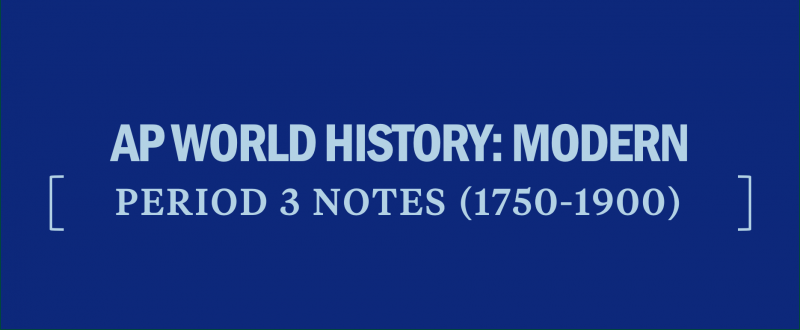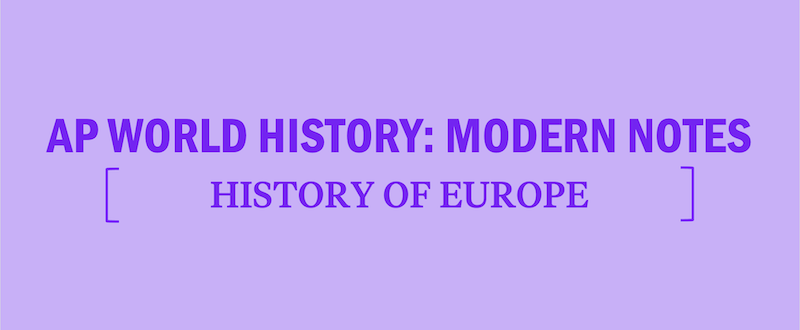How to Approach AP World History: Modern Multiple-Choice Questions
The AP World History: Modern multiple-choice section (Part A of Section I) consists of question sets that typically contain three or four questions and can focus on any historical period from circa 1200 to the present. A primary or secondary source is provided for each question set, which could be a passage, image, graph, or map. The questions assess your ability to understand and analyze historical texts and interpretations, as well as your ability to make larger historical connections. Keep in mind that even if a question set is based on a specific historical period, the individual questions may require you to make connections to other periods and events.
The questions range from easy and medium to difficult with no distinct pattern to their appearance within the exam. In other words, the easiest question may be the last one, so make sure to go through all of the exam questions!
AP World History: Modern Multiple-Choice Strategy
A solid strategy for the multiple-choice section is to do multiple passes:
- On your first pass, answer all of the questions that you know and are sure about.
- Next, go back through the remaining questions. If you can eliminate at least two answer choices and the topic is familiar, take your best educated guess. If you look at the question and do not remember the topic, mark the question with an X in your exam booklet and move on. (If you skip a question, make sure that you skip that line on the answer grid!)
- Go back through the exam for a third time to answer the questions you marked with an X. Again, try to eliminate at least two choices, and take an educated guess. If you’re still not sure, at this point, just bubble in an answer for the question; remember that there is no penalty for guessing on these multiple-choice questions.
- With the time remaining, remove any extraneous marks in your answer grid (such as any X’s you may have left), and make sure that the answers you have bubbled in correspond to the correct numbers in the test booklet.
Sample AP World History: Modern Multiple-Choice Questions
“That [Europe’s] nations could so quickly overcome such a fearful concussion in their external circumstances, and, in general, without retrograding more than they actually did, could so develop their energies in the following century, is a most convincing proof of the indestructibility of human society as a whole. To assume, however, that it did not suffer any essential change internally, because in appearance everything remained as before, is inconsistent with a just view of cause and effect. . . . We, for our parts, are convinced that in the history of the world the Black Death is one of the most important events which have prepared the way for the present state of Europe.
He who studies . . . may perhaps find some proofs of this assertion in the following observations:—at that time, the advancement of the hierarchy was, in most countries, extraordinary; for the Church acquired treasures and large properties in land, even to a greater extent than after the Crusades; but experience has demonstrated that such a state of things is ruinous to the people, and causes them to retrograde, as was evinced on this occasion.”
J. F. C. Hecker, a medical writer, The Black Death, and The Dancing Mania, 1888
Answer 1
C: The Black Death (bubonic plague) spread through infected fleas carried by rodents, but Europeans at the time did not understand this disease vector. Instead interpreting the plague as divine punishment and viewing the Church as powerless to stop it, many Europeans turned to whipping themselves as penance for their sins. Thus, (C) is correct. While the crusades continued in piecemeal fashion into the early fifteenth century, Muslims in the Holy Land were not specifically targeted as scapegoats for the plague. Rather, Jews and other minorities within Europe were. So (A) is incorrect. Although the labor scar- city created by the plague helped end serfdom in Western Europe, it did not do so in Eastern Europe, which suffered comparatively less population loss. That makes (B) incorrect. Europe was largely deforested prior to the plague; the widespread population loss from the plague actually led to reforestation. (D) is incorrect because it suggests the opposite.
Answer 2
D: While the societies and institutions of Western Europe had outwardly endured the plague unaltered, internally they had changed due to, for example, a labor shortage. Workers were able to demand higher wages and greater political rights, such as freedom of movement, which contributed to undermining feudalism. Thus, (d) is correct. Only one-third of the population died in the first five years of the plague, not two-thirds; (A) is incorrect. The English Civil War did not take place until the seventeenth century. In fact, the plague strengthened the power of monarchies throughout Europe; (B) is incorrect. While tempting due to the plague’s impact on the course of the conflict, espe- cially in terms of French manpower loss, (C) is incorrect because the start of the Hundred Years’ War predates the outbreak of the plague in Europe by a decade.
Answer 3
C: Hecker offers a negative characterization of the Catholic Church gaining new lands and money during the plague, suggesting it led to retrogression. In fact, the introduction of added wealth spurred a culture of corruption and wealth-seeking within the Church that helped spark the Protestant Reformation a century and a half later. Thus, (C) is correct. (A) is incorrect because there were only nine official crusades conducted by the Catholic Church, the last of which ended in 1291. Later crusades were regional or national affairs, not overseen by the Church. (B) is incorrect because medical science in this time period was unable to treat the plague. (D) is incorrect because, while the financial gains made by the Church did help fund various Renaissance projects later on, Hecker is referencing a negative outcome for the Church, not a positive one.
Answer 4
A: In the context of the passage, Hecker is referring to near-term positive developments for European civilization after it suffered greatly from the Black Death. The Renaissance was a period of artistic and scientific self-discovery in Europe, particularly from the fourteenth through the sixteenth centuries. Thus, (a) is correct. The First Crusade was called for in 1095, long before the plague; (B) is incorrect. The Enlightenment took place in the seventeenth and eighteenth centuries—too late for Hecker; (C) is incorrect. Although (D) is tempting in the context of the war strengthening English and French identity and government, it is too limited to be correct. The Renaissance had a widespread impact throughout the European continent.
NEXT: How to Approach AP World History: Modern Short Answer Questions




